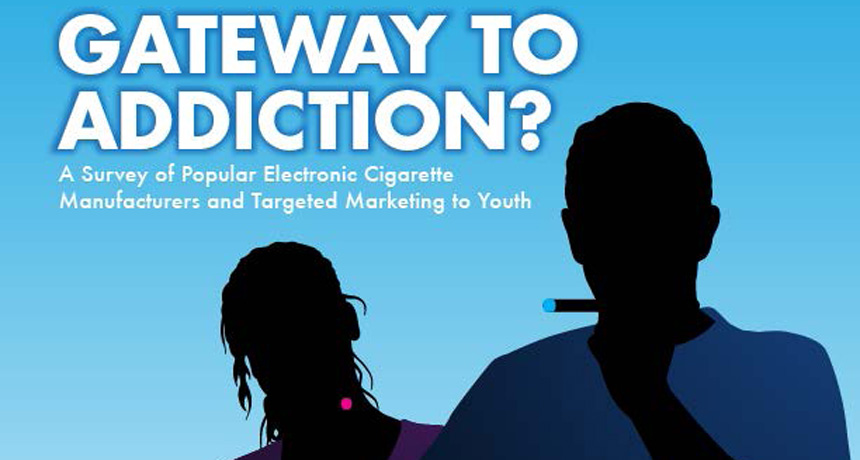According to the Centers for Disease Control and Prevention, 13% of high school age students used e-cigarettes in 2014, up from 4% in 2013. Regulation is being developed, but health effects and related tobacco usage implications are not clear.

Electronic cigarettes are less than 10 years old, and have become increasingly popular in recent years, with a range of new smoking accessories and flavors arriving in the market regularly. E-cigarettes are portable, battery-operated, and relatively odor-free devices that deliver nicotine in a vapor form. They are inhaled like a traditional cigarette, but because the exhaled by-product is a smokeless vapor, e-cigarettes (aka vape pens) are generally viewed as less harmful than traditional tobacco cigarette counterparts.
While they may help curb the use of traditional cigarettes and cigars, the rise of e-cigarettes raises a complicated set of public health questions, and the rapid increase among teens adds a sense of urgency. While 42 states currently ban the sale of e-cigarettes to minors, they can be easily obtained online. The Food and Drug Administration released proposed regulations for e-cigarettes last year, drawing over 70,000 comments. The reason for such scrutiny is likely due to several unknown factors:
First, the health impacts of e-cigarettes themselves are not well understood. Though they are thought to be less harmful than traditional tobacco products, the health impacts of consuming vapor-based nicotine has not been studied over the long-term, and may include unforeseen, harmful consequences. Some have argued that unregulated e-cigarettes are actually more harmful than traditional tobacco products due to the presence of chemicals such as formaldehyde and acetaldehyde, which are used in building materials, embalming fluids and disinfectants.
Second, e-cigarettes are habit-forming. Smoking vapor is less abrasive on the user's mouth, throat and lungs, and the combination of addictive nicotine, pleasing flavors, and a perception of greater tolerance on behalf of bystanders can lead to e-cigarette users smoking more frequently than they would a traditional cigarette. In this light, the long-term health effects of e-cigarettes smoking would need to also account for potentially higher consumption of nicotine in comparison to the amount of nicotine that an average traditional smoker consumes. A better understanding of the higher-nicotine versus lower-tobacco-smoke tradeoff (among other variables) would help in establishing guidelines for moderate and safe e-cigarette use.
Third, the health impact to second-hand smokers is also not well understood. The rights of bystanders, and whether e-cigarettes are included in, for example, existing indoor and public spaces smoking bans, will need to consider both health and aesthetic impacts.
Fourth, behavioral implications are not well understood. The promise of e-cigarettes is that existing traditional cigarette users may shift to e-cigarettes as an alternative, in an effort to reduce -- and ultimately quit--a smoking habit. In contrast, the pitfall of e-cigarettes is that they could entice new users who wouldn't otherwise choose to smoke, knowing the dangers of traditional tobacco products.
The surge in e-cigarette use among teens is alarming because of what is already known about the consequences of peer pressure, and how early smoking habits can extend well into adulthood. A campaign to educate the public about the dangers of smoking has been waged for decades, with a key message to young people of, "smoking is not cool and can kill you." The extent to which a new e-cigarette habit becomes a gateway to tobacco use is not well understood, and could undermine the promise of e-cigarettes helping to reduce overall tobacco usage.
Fifth, the current marketing of e-cigarettes is not balanced with a broad, objective campaign to educate the public about its health effects. And yet the industry does continue to move forward with marketing efforts to expand the user base. This is seen in print and video advertising sometimes featuring celebrities and other images that resonate with young audiences.
Perhaps the biggest danger of this marketing trend is that it could not only send the wrong message to young people about e-cigarette safety, but could undo generations of hard-fought public education about tobacco. The rapid increase among young people might mean this is already happening.
FULL STORY: Teen e-cigarette use tripled in the past year

Planetizen Federal Action Tracker
A weekly monitor of how Trump’s orders and actions are impacting planners and planning in America.

Map: Where Senate Republicans Want to Sell Your Public Lands
For public land advocates, the Senate Republicans’ proposal to sell millions of acres of public land in the West is “the biggest fight of their careers.”

Restaurant Patios Were a Pandemic Win — Why Were They so Hard to Keep?
Social distancing requirements and changes in travel patterns prompted cities to pilot new uses for street and sidewalk space. Then it got complicated.

Platform Pilsner: Vancouver Transit Agency Releases... a Beer?
TransLink will receive a portion of every sale of the four-pack.

Toronto Weighs Cheaper Transit, Parking Hikes for Major Events
Special event rates would take effect during large festivals, sports games and concerts to ‘discourage driving, manage congestion and free up space for transit.”

Berlin to Consider Car-Free Zone Larger Than Manhattan
The area bound by the 22-mile Ringbahn would still allow 12 uses of a private automobile per year per person, and several other exemptions.
Urban Design for Planners 1: Software Tools
This six-course series explores essential urban design concepts using open source software and equips planners with the tools they need to participate fully in the urban design process.
Planning for Universal Design
Learn the tools for implementing Universal Design in planning regulations.
Heyer Gruel & Associates PA
JM Goldson LLC
Custer County Colorado
City of Camden Redevelopment Agency
City of Astoria
Transportation Research & Education Center (TREC) at Portland State University
Camden Redevelopment Agency
City of Claremont
Municipality of Princeton (NJ)



























